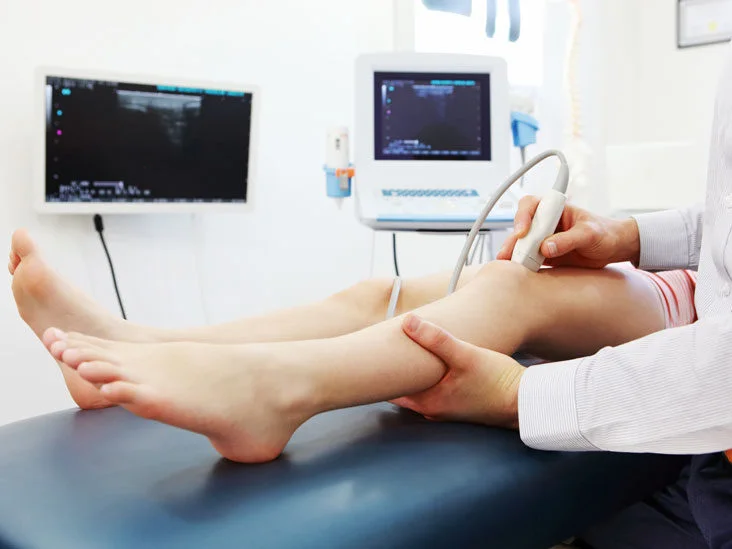Peripheral Arterial Doppler Ultrasound – ABPI One Limb - Price: £240
At London Private Ultrasound, we offer advanced diagnostic services that include Peripheral Arterial Doppler Ultrasound and Ankle Brachial Pressure Index (ABPI) assessment. These non-invasive procedures play a key role in evaluating blood flow and vascular health in your arms and legs.
Peripheral Arterial Doppler Ultrasound
Our Peripheral Arterial Doppler Ultrasound uses high-frequency sound waves to take a close look at the blood vessels in your arms and legs. This specialized imaging technique helps us spot any blockages, narrowing (stenosis), or other issues in the peripheral arteries, allowing for early diagnosis and treatment of vascular conditions.
Ankle Brachial Pressure Index (ABPI)
The ABPI test measures the blood pressure in your ankle and compares it to the pressure in your arm’s brachial artery. This painless and non-invasive test provides valuable insights into your vascular health, helping us detect Peripheral Arterial Disease (PAD) early. With this information, we can guide treatment decisions and work to reduce the risk of complications.
Book Online Peripheral Arterial Doppler Ultrasound – ABPI One Limb
If you are unable to make a payment online, please call our office to book your appointment. We’re here to assist you! Tel: 020 7101 3377
ExcellentBased on 540 reviews Trustindex verifies that the original source of the review is Google.
Trustindex verifies that the original source of the review is Google. Jackie Supernova2024-07-16excellent service. easy to book and adjust dates if required. The staff are friendly. The clinician was attentive and informative and did a thorough investigation. Highly recommend if you need fast reliable diagnostic results.Trustindex verifies that the original source of the review is Google.
Jackie Supernova2024-07-16excellent service. easy to book and adjust dates if required. The staff are friendly. The clinician was attentive and informative and did a thorough investigation. Highly recommend if you need fast reliable diagnostic results.Trustindex verifies that the original source of the review is Google. Mostafa Hawwash2024-07-16Quick and fast and reliable. Thank youTrustindex verifies that the original source of the review is Google.
Mostafa Hawwash2024-07-16Quick and fast and reliable. Thank youTrustindex verifies that the original source of the review is Google. Aisha Fontaine2024-07-16Reza Farahmandfar, was very professional, my appointment was on time. He explained every step of the way. Definitely will book with him again.Trustindex verifies that the original source of the review is Google.
Aisha Fontaine2024-07-16Reza Farahmandfar, was very professional, my appointment was on time. He explained every step of the way. Definitely will book with him again.Trustindex verifies that the original source of the review is Google. Sammy Andrews2024-07-15Brilliant clinic. I've visited a few the last few years for various issues and London Private Ultrasound was prompt, clean, professional and reassuring. If I need anything else I will definitely go back.Trustindex verifies that the original source of the review is Google.
Sammy Andrews2024-07-15Brilliant clinic. I've visited a few the last few years for various issues and London Private Ultrasound was prompt, clean, professional and reassuring. If I need anything else I will definitely go back.Trustindex verifies that the original source of the review is Google. Matt Mawson2024-07-14Friendly, reassuring, calm manner with a easy to understand explanation of the details. Highly recommended.Trustindex verifies that the original source of the review is Google.
Matt Mawson2024-07-14Friendly, reassuring, calm manner with a easy to understand explanation of the details. Highly recommended.Trustindex verifies that the original source of the review is Google. uday singh2024-07-10I was there for my lower limb ultrasound but the quality of explanation by the doctor was so comprehensive that I decided to get a full body scan. Greatly impressed with the attention and attitude of everyone there. If anyone requires an ultrasound, in my view this is the place.Trustindex verifies that the original source of the review is Google.
uday singh2024-07-10I was there for my lower limb ultrasound but the quality of explanation by the doctor was so comprehensive that I decided to get a full body scan. Greatly impressed with the attention and attitude of everyone there. If anyone requires an ultrasound, in my view this is the place.Trustindex verifies that the original source of the review is Google. Aisha Smith2024-07-09Great experience, got an appointment within an hour. Sonographer was lovely and really reassuring and was useful to be able to see the images on the large screen while lying down.Trustindex verifies that the original source of the review is Google.
Aisha Smith2024-07-09Great experience, got an appointment within an hour. Sonographer was lovely and really reassuring and was useful to be able to see the images on the large screen while lying down.Trustindex verifies that the original source of the review is Google. Joana Macedo2024-07-08Same day scan. Very knowledgeable clinician. Thanks
Joana Macedo2024-07-08Same day scan. Very knowledgeable clinician. Thanks


